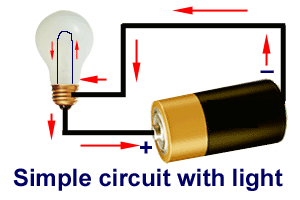Lighting a Lamp

Above is an example of how a wire should NOT be connected to a flashlight
battery. If you do this, the wire could become very
hot and even start a fire. Never connect only a wire from the
negative end of a battery to the positive end like in the above
picture. The current in the circuit will be too high because there is
no resistance in the path to limit current flow. Current is
electrons flowing through a wire in a circuit. The red
arrows indicate the direction the electrons will travel through the wire.
Electrons travel from the negative terminal of the battery to the positive
terminal of the battery but only when there is a path (wire) for them to flow
through.

This is the correct way
to hook up a circuit to a battery. Notice that the lamp in the circuit
makes the circuit safe by limiting the amount of current flowing in the
wires. The lamp has resistance. Resistance
is the opposition to current flow. The resistance of the lamp holds
back the current to a safe level.
Question:
Why do electrons flow from the
negative side of the battery to the positive side of the battery?
Answer:
Electrons have a negative
charge. If two charged objects have the same charge, they repel each
other. If
two charged objects have unlike charges, they attract each other. Since
electrons have a negative charge, they are repelled from the negative terminal
of the battery which also has a negative charge. Electrons are attracted
towards the positive terminal of the battery because the negative electrons are
attracted by positive. Opposites attract!
Experiment One
Follow the steps below
-
Ask your parents if it is okay to take apart a flashlight, or see if you
can find a broken one to use.
-
Take the flashlight apart until you get down to the lamp. The lamp
will be in a holder of some kind. Take the lamp out of the
holder. Get your mom or dad to help if
necessary.
-
Next, you will need a good flashlight battery. Use ONLY a 1.5V
battery that looks similar to the one in the picture. You do not need a new
one, but the battery can't be completely dead either.
-
Find two small pieces of copper wire about 9 inches long. You may use only one piece of wire or
use two pieces if you need them.
-
Now construct the Simple circuit with light in the
above picture. Use tape to connect the wire to the ends of the
battery. (To make a better mechanical connection, wrap the bare end of
the wire around a small piece of aluminum foil. Wrap the aluminum foil
into a small pea sized lump and then tape that to the battery
terminal.)
-
Get some help from someone if you can't hold all the ends of wires to the
proper places.
Having trouble?
-
Make sure there is metal showing at the ends of the wire, you must remove
the insulation and connect the metal wire to the metal of the battery and
bulb.
-
Compare your circuit to the pictures above. Remember do not put a
wire from positive to negative on the battery, you could start a
fire.
-
Look closely at the light bulb, you must connect one wire to the end and
the other wire to the side where the threads are or where the slick shiny
metal is.
-
Try another battery, the one you are using may be dead.
-
Look closely at the little loop of wire inside the light bulb. If
the wire is broken inside, the bulb is blown and you have to get another
one.
What to Notice
-
You should have noticed that the only way the lamp will light is if there
is a complete path for current (electrons) to flow around the
circuit.
-
Electrons flow from the negative side of the battery through the lamp and
back to the positive side of the battery. If there is a break in the
circuit anywhere, the current stops flowing and the lamp goes
out.
Discoveries
-
The lamp lights dimly because most flashlight bulbs have enough resistance
to limit the current to a safe level when 3V are applied. We
only used 1.5V for this experiment. When you connect two batteries in
series the voltages add together. 1.5V + 1.5V = 3V Three volts
will light your lamp brightly. It is a little bit difficult to connect
two flashlight batteries together. If your flashlight bulb came from a
two cell flashlight, you can try to connect them in series with tape and
then light your lamp. (Do not connect the
flashlight bulb to more voltage than it is supposed to have, you may be
injured).
-
Current is electrons moving through a wire.
-
A circuit must have resistance (our lamp is the resistance) in the path to
limit the current to a safe level.
-
Current flows from the negative side of a battery to the positive side of
the battery.
-
For current to flow, there must be a complete path (no breaks in the
circuit).
-
If a wire connects strait from the negative side of a battery to the
positive side of the battery with no resistance in the path, this is called
a short and is dangerous. This could start a fire because the current
will be very high.
Now report to me and let me know if you were able to light the lamp by clicking
here. Be sure to tell me your name and what state your from.
At this time you may wish to stop for the day or you may continue with the
next experiment by clicking the next link in the menu to your left.


